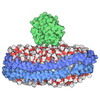[English] 日本語
 Yorodumi
Yorodumi- PDB-9bwc: Homomeric alpha3 glycine receptor in the presence of 0.1 mM glyci... -
+ Open data
Open data
- Basic information
Basic information
| Entry | Database: PDB / ID: 9bwc | |||||||||||||||||||||
|---|---|---|---|---|---|---|---|---|---|---|---|---|---|---|---|---|---|---|---|---|---|---|
| Title | Homomeric alpha3 glycine receptor in the presence of 0.1 mM glycine at pH 6.4 in an apo state | |||||||||||||||||||||
 Components Components | Glycine receptor subunit alpha-3 | |||||||||||||||||||||
 Keywords Keywords | MEMBRANE PROTEIN / Glycine / Ion Channel / Ligand-Gated / Pentameric | |||||||||||||||||||||
| Function / homology |  Function and homology information Function and homology informationglycine-gated chloride ion channel activity / glycine-gated chloride channel complex / Neurotransmitter receptors and postsynaptic signal transmission / extracellularly glycine-gated chloride channel activity / glycinergic synapse / glycine binding / presynaptic modulation of chemical synaptic transmission / chloride transmembrane transport / protein homooligomerization / transmembrane signaling receptor activity ...glycine-gated chloride ion channel activity / glycine-gated chloride channel complex / Neurotransmitter receptors and postsynaptic signal transmission / extracellularly glycine-gated chloride channel activity / glycinergic synapse / glycine binding / presynaptic modulation of chemical synaptic transmission / chloride transmembrane transport / protein homooligomerization / transmembrane signaling receptor activity / presynaptic membrane / perikaryon / postsynaptic membrane / intracellular membrane-bounded organelle / dendrite / metal ion binding / plasma membrane Similarity search - Function | |||||||||||||||||||||
| Biological species |  Homo sapiens (human) Homo sapiens (human) | |||||||||||||||||||||
| Method | ELECTRON MICROSCOPY / single particle reconstruction / cryo EM / Resolution: 2.19 Å | |||||||||||||||||||||
 Authors Authors | Kindig, K. / Gibbs, E. / Chakrapani, S. | |||||||||||||||||||||
| Funding support |  United States, 6items United States, 6items
| |||||||||||||||||||||
 Citation Citation |  Journal: Sci Adv / Year: 2024 Journal: Sci Adv / Year: 2024Title: Mechanisms underlying modulation of human GlyRα3 by Zn and pH. Authors: Kayla Kindig / Eric Gibbs / David Seiferth / Philip C Biggin / Sudha Chakrapani /   Abstract: Glycine receptors (GlyRs) regulate motor control and pain processing in the central nervous system through inhibitory synaptic signaling. The subtype GlyRα3 expressed in nociceptive sensory neurons ...Glycine receptors (GlyRs) regulate motor control and pain processing in the central nervous system through inhibitory synaptic signaling. The subtype GlyRα3 expressed in nociceptive sensory neurons of the spinal dorsal horn is a key regulator of physiological pain perception. Disruption of spinal glycinergic inhibition is associated with chronic inflammatory pain states, making GlyRα3 an attractive target for pain treatment. GlyRα3 activity is modulated by numerous endogenous and exogenous ligands that consequently affect pain sensitization. To understand the mechanism of two such endogenous modulators, Zn and protons, we have used cryo-electron microscopy to determine structures of full-length human GlyRα3 in various functional states. Whereas acidic pH reduces peak glycine response, Zn displays biphasic modulation in a concentration-dependent manner. Our findings reveal the effector sites and also capture intermediate conformations in the gating cycle. Combined with molecular dynamics simulations and electrophysiology, this work provides important insights into GlyRα3 activation and regulation. | |||||||||||||||||||||
| History |
|
- Structure visualization
Structure visualization
| Structure viewer | Molecule:  Molmil Molmil Jmol/JSmol Jmol/JSmol |
|---|
- Downloads & links
Downloads & links
- Download
Download
| PDBx/mmCIF format |  9bwc.cif.gz 9bwc.cif.gz | 460.9 KB | Display |  PDBx/mmCIF format PDBx/mmCIF format |
|---|---|---|---|---|
| PDB format |  pdb9bwc.ent.gz pdb9bwc.ent.gz | 347.1 KB | Display |  PDB format PDB format |
| PDBx/mmJSON format |  9bwc.json.gz 9bwc.json.gz | Tree view |  PDBx/mmJSON format PDBx/mmJSON format | |
| Others |  Other downloads Other downloads |
-Validation report
| Summary document |  9bwc_validation.pdf.gz 9bwc_validation.pdf.gz | 2 MB | Display |  wwPDB validaton report wwPDB validaton report |
|---|---|---|---|---|
| Full document |  9bwc_full_validation.pdf.gz 9bwc_full_validation.pdf.gz | 2 MB | Display | |
| Data in XML |  9bwc_validation.xml.gz 9bwc_validation.xml.gz | 62.6 KB | Display | |
| Data in CIF |  9bwc_validation.cif.gz 9bwc_validation.cif.gz | 86.1 KB | Display | |
| Arichive directory |  https://data.pdbj.org/pub/pdb/validation_reports/bw/9bwc https://data.pdbj.org/pub/pdb/validation_reports/bw/9bwc ftp://data.pdbj.org/pub/pdb/validation_reports/bw/9bwc ftp://data.pdbj.org/pub/pdb/validation_reports/bw/9bwc | HTTPS FTP |
-Related structure data
| Related structure data |  44964MC  9bu2C 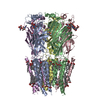 9bu3C  9bvhC  9bvjC  9bwbC  9bweC  9bwgC  9bwjC  9bzpC M: map data used to model this data C: citing same article ( |
|---|---|
| Similar structure data | Similarity search - Function & homology  F&H Search F&H Search |
- Links
Links
- Assembly
Assembly
| Deposited unit | 
|
|---|---|
| 1 |
|
- Components
Components
-Protein / Sugars , 2 types, 10 molecules ABCDE
| #1: Protein | Mass: 55581.066 Da / Num. of mol.: 5 Source method: isolated from a genetically manipulated source Source: (gene. exp.)  Homo sapiens (human) / Gene: GLRA3 Homo sapiens (human) / Gene: GLRA3Production host:  Spodoptera aff. frugiperda 1 BOLD-2017 (butterflies/moths) Spodoptera aff. frugiperda 1 BOLD-2017 (butterflies/moths)References: UniProt: O75311 #2: Polysaccharide | 2-acetamido-2-deoxy-beta-D-glucopyranose-(1-4)-2-acetamido-2-deoxy-beta-D-glucopyranose Source method: isolated from a genetically manipulated source |
|---|
-Non-polymers , 4 types, 70 molecules 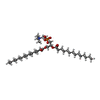
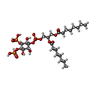
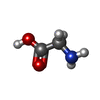




| #3: Chemical | ChemComp-PX4 / #4: Chemical | ChemComp-PIO / [( #5: Chemical | ChemComp-GLY / #6: Water | ChemComp-HOH / | |
|---|
-Details
| Has ligand of interest | Y |
|---|---|
| Has protein modification | Y |
-Experimental details
-Experiment
| Experiment | Method: ELECTRON MICROSCOPY |
|---|---|
| EM experiment | Aggregation state: PARTICLE / 3D reconstruction method: single particle reconstruction |
- Sample preparation
Sample preparation
| Component | Name: Pentameric Assembly of Human Glycine Receptor Subtype Alpha3 Type: COMPLEX / Entity ID: #1 / Source: RECOMBINANT |
|---|---|
| Molecular weight | Value: .25 MDa / Experimental value: NO |
| Source (natural) | Organism:  Homo sapiens (human) Homo sapiens (human) |
| Source (recombinant) | Organism:  Spodoptera aff. frugiperda 1 BOLD-2017 (butterflies/moths) Spodoptera aff. frugiperda 1 BOLD-2017 (butterflies/moths) |
| Buffer solution | pH: 6.4 |
| Specimen | Embedding applied: NO / Shadowing applied: NO / Staining applied: NO / Vitrification applied: YES |
| Specimen support | Grid material: COPPER / Grid mesh size: 300 divisions/in. / Grid type: Quantifoil R1.2/1.3 |
| Vitrification | Cryogen name: ETHANE |
- Electron microscopy imaging
Electron microscopy imaging
| Experimental equipment |  Model: Titan Krios / Image courtesy: FEI Company |
|---|---|
| Microscopy | Model: FEI TITAN KRIOS |
| Electron gun | Electron source:  FIELD EMISSION GUN / Accelerating voltage: 300 kV / Illumination mode: FLOOD BEAM FIELD EMISSION GUN / Accelerating voltage: 300 kV / Illumination mode: FLOOD BEAM |
| Electron lens | Mode: BRIGHT FIELD / Nominal defocus max: 2000 nm / Nominal defocus min: 750 nm |
| Image recording | Electron dose: 60 e/Å2 / Film or detector model: GATAN K3 BIOQUANTUM (6k x 4k) |
- Processing
Processing
| CTF correction | Type: PHASE FLIPPING AND AMPLITUDE CORRECTION |
|---|---|
| Symmetry | Point symmetry: C5 (5 fold cyclic) |
| 3D reconstruction | Resolution: 2.19 Å / Resolution method: FSC 0.143 CUT-OFF / Num. of particles: 132119 / Symmetry type: POINT |
 Movie
Movie Controller
Controller











 PDBj
PDBj

